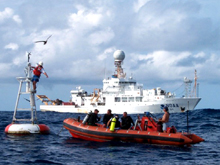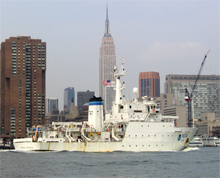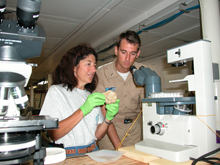NOAA Fleet Gets Younger and Better Looking
NOAA's ship fleet provides hydrographic survey, oceanographic and atmospheric research and fisheries research vessels to help NOAA understand and predict changes in the Earth's environment and wisely manage coastal and marine resources. The NOAA ship fleet currently consists of 19 active ships located in waters on the East and West coasts, the Gulf of Mexico, Alaska, and Hawaii.
- Introduction
- That Was Then: 1997
- 2003: A Banner Year
- A Few More Join the Fleet
- A New Class
- Surveying Gets a Boost
- Fleet Modernization Plan
- Fleet Age Is Going Backward
- Meet the Fleet

Oscar Dyson, a NOAA ship launched in 2003, was the first of four new fisheries survey vessels of the same design. Click image for larger view.
The NOAA fleet of ships is doing what many of us only dream of: it has reversed the aging process by getting younger, more capable, and better looking.
For years, the aging of the fleet has been of concern to NOAA. Old ships are costly to operate and maintain, and ship technology was not keeping pace with expanding needs. In the past decade, however, NOAA has made great strides in modernizing the fleet with the help of the U.S. Navy and through new ship construction.
That Was Then: 1997
In 1997, there were 15 ships in the NOAA fleet. The average age of ships in the fleet was 28 years. The technologies of that time were earlier versions of the state-of-the-art technologies that exist today in all systems: precise navigation, communications (including real-time transmission of scientific data), hydrographic and biomass sonar systems, oceanographic data collection, and plant engineering. The commissioning of Ronald H. Brown in 1997 made it a milestone year for the agency. Brown was equipped with meteorological and ocean data-collecting capabilities—including a Doppler radar to study storm dynamics at sea—that were unique in the U.S. civilian fleet.
End of the Cold War Pumps Up the NOAA Fleet
The end of the Cold War netted NOAA a bonanza: the U.S. Navy no longer needed its nearly new T-AGOS class submarine detection ships. Over the past decade, the Navy has transferred six of these ships to NOAA. Another former Navy T-AGOS was acquired by NOAA through the Coast Guard. The Navy also transferred to NOAA a surplus T-AGS ship, a hydrographic survey vessel that needed no major conversion and was about 27 years newer than the ship it replaced. A yard torpedo test (YTT) vessel was also transferred to NOAA by the Navy.
Through conversion of these Navy ships and new vessel construction, the NOAA fleet is being revitalized to meet NOAA’s needs for better data collection technologies in modern vessels that are more cost efficient as well as more habitable for the crew and scientists.

Ronald H. Brown was commissioned in 1997 as the world’s most technologically advanced oceanographic research ship, complete with the first domestic ship-borne Doppler radar. In this photo, the ship is servicing a TAO (Tropical Atmosphere and Ocean) buoy.
Even with the addition of Ronald H. Brown and Oscar Dyson, a new fisheries survey vessel in operation since May 2005, the Navy ship transfers have thus far had the largest impact on the state of the fleet. Ka’imimoana and Gordon Gunter were the first T-AGOS ships received from the Navy; they were commissioned in 1996 and 1998, respectively.
“We have been working in partnership with the Navy to continue to use assets for the nation’s benefit,” said Rear Admiral Samuel P. De Bow Jr., director of the NOAA Corps and NOAA’s Office of Marine and Aviation Operations, which operates and manages the fleet. “The amount of money we spend on converting the Navy ships to meet NOAA’s specific mission requirements are dollars well spent. This is an effective way to use national assets that still have years of viable use left in them.”
2003: A Banner Year
The fleet has gone through some major changes in the past several years. In particular, 2003 was a banner year for fleet modernization. NOAA decommissioned the 37-year-old hydrographic ship Whiting and replaced it with the 10-year-old Navy T-AGS ship Littlehales. This was the first hydrographic ship transferred to NOAA from the Navy. (The Navy conducts surveys for the National Geospatial Intelligence Agency, which creates the Navy’s nautical charts of international coastlines.)
Littlehales was renamed Thomas Jefferson and is currently serving as the flagship for NOAA's 200th anniversary celebration. The 39-year-old McArthur was decommissioned in 2003. Its replacement, the 18-year-old Navy T-AGOS vessel Indomitable, was commissioned McArthur II during the same ceremony, effectively transferring the responsibilities from one ship to the other.

Thomas Jefferson is a former Navy T-AGS class ship which required no major conversion. It conducts hydrographic surveys in support of NOAA’s nautical charting mission. Here, the ship is surveying New York Harbor. Click image for larger view.
NOAA quickly put Thomas Jefferson and McArthur II into service by installing equipment and transferring the crew off the older ships to the newer ones.
“Because these ships were still operational when they were transferred to NOAA, we could put them into use almost immediately using the operating funds allocated for the ships they replaced,” De Bow said. “We later got funding for some minor structural conversions for more lab space, more berthing for scientists, and other changes that optimized the ships to best meet NOAA’s specific needs. These platforms were more modern and reliable, less expensive to operate and maintain, and far more comfortable and spacious for those who live on board.”
Also in 2003, Navy T-AGOS vessel Adventurous was commissioned Oscar Elton Sette, replacing the NOAA fisheries ship Townsend Cromwell. The ship Ferrel was replaced by the Navy YTT vessel Agate Pass, which was renamed Nancy Foster.
A Few More Join the Fleet
NOAA also obtained the Navy T-AGOS vessel Vindicator, which was originally transferred to the U.S. Coast Guard. The vessel was converted for research and commissioned Hi’ialakai in 2004.

The Hi’ialakai is one of seven former Navy T-AGOS class ships transferred to NOAA. Click image for larger view and full caption.
Former Navy ship Assertive was transferred to NOAA in 2004 and will replace an older vessel once converted.
In 2004, Congress passed legislation calling for the Navy to transfer to NOAA a ship that would be dedicated solely to ocean exploration and research. The Navy transferred another T-AGOS ship, Capable, to NOAA along with funding to convert it for research. The “telepresence” technology associated with this ship, which will allow scientists in shore stations to conduct research as though they were on board, is unlike anything the agency has previously done. The ship has been renamed Okeanos Explorer, a name selected through a student contest, and is expected to go on line in 2008.
Though obtaining the Navy vessels has helped modernize the fleet, these ships have not all been a perfect fit for NOAA activities. T-AGOS ships, for example, convert well to conduct oceanographic research, but cannot meet all the requirements for fisheries work.
A New Class to Transform NOAA Fisheries Research
New fisheries survey vessels (FSVs) that meet stringent international standards will form the backbone of the future fisheries fleet. Four FSVs were originally planned for and funded. Two have been delivered and the second two are in various stages of construction.
Since its commissioning in May 2005, the first ship, Oscar Dyson, has operated from its home port in Kodiak, Alaska. The second ship, Henry B. Bigelow, was delivered in July 2006, and will be commissioned in early 2007. The ship will work primarily in New England waters, supporting the Northeast Fisheries Science Center. Bigelow will replace the 44-year-old Albatross IV. Henry B. Bigelow was named by a team of students from New Hampshire in NOAA’s first educational “Name a NOAA Ship” contest.

Pisces, the third of four new fisheries survey vessels, will be launched in 2007. In the photo, ship sponsor Dr. Annette Nevin Shelby, wife of the Senator from Alabama, welds her name on the ship’s keel plate during the 2006 keel-laying ceremony.
Pisces, the third FSV—also named through a student contest—will be christened and launched in 2007. Completion of construction and delivery of the ship is expected in 2008. Pisces will be homeported in Pascagoula, Mississippi, replacing the 40-year-old Oregon II.
Construction began on the fourth FSV in June 2006. The ship is scheduled for delivery in 2009 and will conduct fisheries work on the West coast of the U.S.
“These world-class FSVs are needed to meet the very specific data collection requirements of NOAA Fisheries and low acoustic signatures in accordance with tough international sampling standards,” De Bow said. “They also have the combined capabilities of doing heavy trawling and environmental data collection – something the T-AGOS ships can’t do, and that is unavailable in the private sector.”
NOAA’s Hydrographic Surveying Gets a Boost
The addition of the Thomas Jefferson to the fleet was a big plus for NOAA’s hydrographic survey capabilities, which support NOAA’s creation of nautical charts.

A Small Waterplane Area Twin Hull coastal mapping vessel—the first hydrographic survey vessel of its kind for NOAA—is currently under construction. Its stable design makes it ideal for acquiring reliable data in choppy waters. This is an artist’s rendition of the completed vessel.
NOAA ship Fairweather, which had been inactive since 1988, was reactivated after a complete refurbishment and began survey operations in Alaska in 2004. Fairweather is a sister ship to Rainier, which also conducts hydrographic surveys in Alaska but has not been refurbished. All of NOAA’s survey ships were upgraded with state-of-the-art sonar systems and data acquisition technology in 2002, making them among the most advanced survey platforms in the world.
A new ship that is currently being designed is a SWATH (Small Waterplane Area Twin Hull) hydrographic survey vessel that is intended to replace the 40-year-old Rude. The SWATH will be home ported in New Castle, New Hampshire, near the University of New Hampshire/NOAA Joint Hydrographic Center. The vessel is being designed for charting work and will conduct surveys and be used for training and equipment development programs.
Fleet Modernization Plan Supports NOAA Objectives
NOAA's Office of Marine and Aviation Operations has developed a 10-year “fleet modernization plan” that includes a mix of in-house and outsourced vessels needed to achieve NOAA’s objectives using current technology and the most cost-effective, reliable platforms.
“We have tried to work closely with the [NOAA] offices to ensure that we get the resources needed to help them meet their mission objectives. Getting funding for the FSVs is a good example of this cooperation. We were also able to take advantage of the Navy’s excess ships on short notice because we already had a plan in place and knew exactly how they could be best utilized,” De Bow said.
Fleet Age Is Going Backward

A NOAA Corps officer assists a scientist aboard Ronald H. Brown during a bio-prospecting cruise to discover new species. NOAA Corps officers operate and manage NOAA ships, and provide research support as well. Click image for larger view.
Retired Navy Vice Admiral Conrad C. Lautenbacher, Jr., under secretary of commerce for oceans and atmosphere, noted shortly after the Pisces keel-laying ceremony in June 2006 that the age of the NOAA fleet continues to decrease. Specifically, he said, “In just four years, the average age of our fleet has reduced from 32 years old to 27 years old. I’m very proud to report that with the delivery of these new ships and the decommissioning of some older ships, the average age of the fleet will be down to 22 years by 2009.”
Meet the Fleet
Currently, NOAA has 19 active ships in the fleet, plus one undergoing conversion and one awaiting funding.
Ronald H. Brown (oceanographic research)
Ka'imimoana (oceanographic research)
Henry B. Bigelow (fisheries research—to be commissioned in 2007; not pictured)
Oscar Dyson (fisheries research)
Oscar Elton Sette (fisheries research)
Miller Freeman (fisheries research)
John N. Cobb (fisheries research)
David Starr Jordan (fisheries research)
Gordon Gunter (fisheries research)
Oregon II (fisheries research)
Albatross IV (fisheries research)
Delaware II (fisheries research)
Fairweather (hydrographic surveying)
Rainier (hydrographic surveying)
Rude (hydrographic surveying)
Thomas Jefferson (hydrographic surveying)
Nancy Foster (multipurpose/coastal research)
McArthur II (multipurpose/coastal research)
Hi'ialakai (multipurpose/coastal research)
